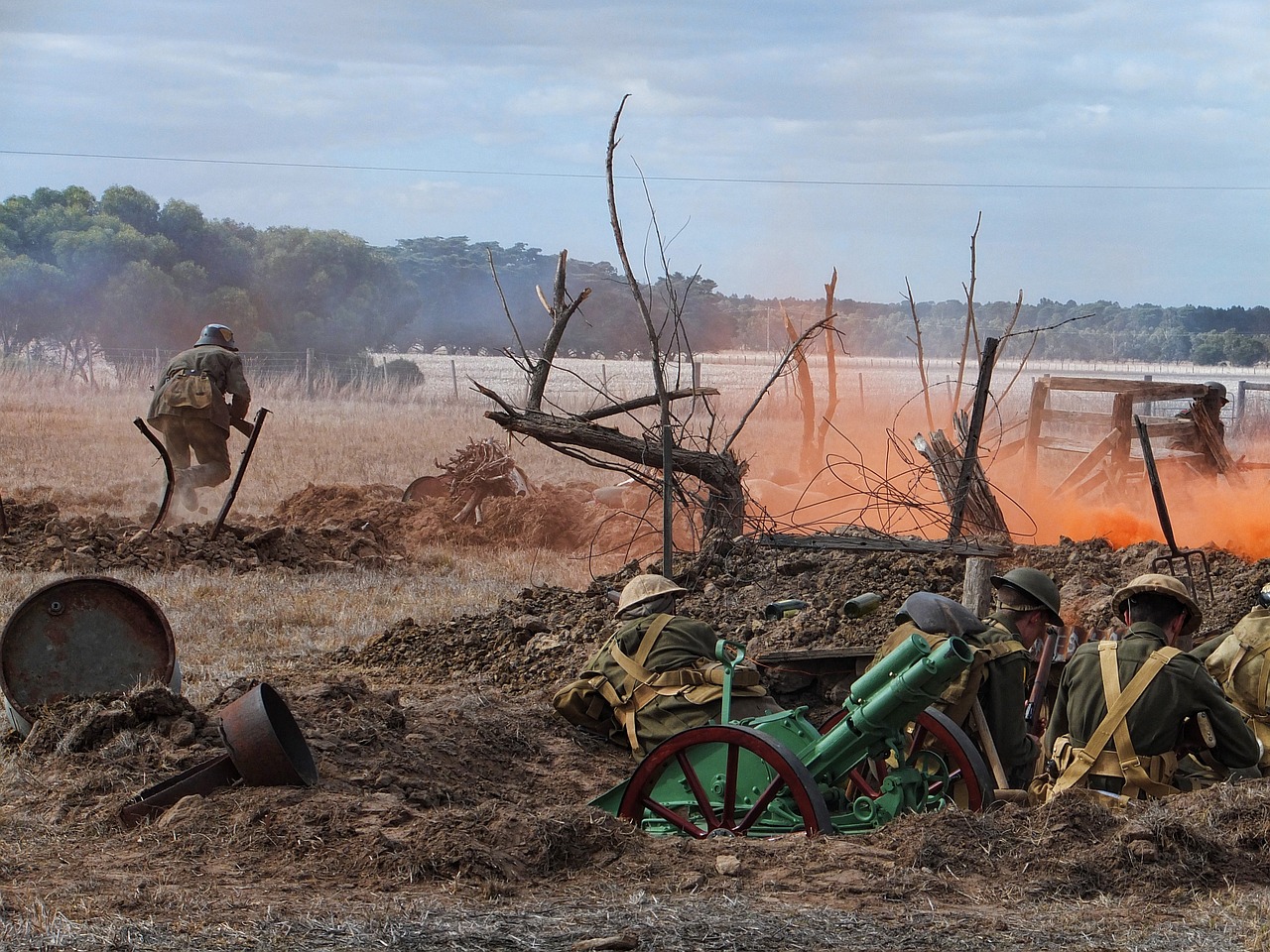The First World War: Causes, Alliances, and Key Figures
The First World War, also known as the Great War, erupted in 1914 due to a complex web of political, economic, and social tensions. Its immediate trigger was the assassination of Archduke Franz Ferdinand of Austria-Hungary, but the underlying causes included militarism, nationalism, imperial rivalries, and a tangled system of alliances that drew multiple countries into conflict.
On one side were the Allied Powers, primarily France, Britain, and Russia, later joined by countries like Italy and the United States. Opposing them were the Central Powers, led by Germany, Austria-Hungary, and the Ottoman Empire.
Key figures of the war included military and political leaders like Kaiser Wilhelm II of Germany, Tsar Nicholas II of Russia, President Woodrow Wilson of the U.S., and Prime Minister David Lloyd George of Britain. The war reshaped global politics, economies, and societies, ultimately setting the stage for the tumultuous decades that followed.
The Assassination that Sparked World War I
On June 28, 1914, Archduke Franz Ferdinand, heir to the Austro-Hungarian throne, was assassinated alongside his wife during an official visit to Sarajevo. The assassin, Gavrilo Princip, was a student and a member of a Bosnian irredentist group with nationalist ambitions. The Austro-Hungarian government held Serbia largely responsible, as the young and rapidly growing state was a beacon for Slavic nationalism in the Balkans, which threatened Austria-Hungary’s influence in the region.
Backed by Germany, Austria delivered a harsh ultimatum to Serbia on July 23, demanding that Austrian officials oversee the investigation into the assassination. Serbia, in defense of its national sovereignty, politely refused. With tensions at a breaking point, Austria-Hungary declared war on Serbia on July 28, 1914, marking the beginning of the First World War.
The Balkan Conflict and the Global Chain Reaction
Although there had been previous conflicts in the Balkans, Austria’s involvement in 1914 triggered a complex web of global alliances.
In support of Serbia, Russia swiftly mobilized its troops, driven by shared Orthodox faith and its strategic interest in dominating the Balkans. Germany, Austria’s ally, demanded that Russia stand down and urged France to remain neutral. When both powers refused, Germany declared war on them in early August. On August 4, Germany invaded Belgium after the country denied German troops passage.
This invasion brought Great Britain into the conflict in defense of France and Belgium. Meanwhile, Italy, though formally allied with Austria and Germany, declared its neutrality for the time being. On August 23, Japan declared war on Germany due to the presence of a German fleet in the Far East, posing a threat. By November, the Ottoman Empire had entered the war, declaring hostilities against Russia.
Thus, a localized Balkan conflict quickly escalated into a global war.
Global Involvement in the First World War
As the conflict progressed, numerous other nations joined the fray. Italy, the United States, Romania, and Greece eventually sided with the Russian-French alliance, while Bulgaria aligned with the German-Austrian front. The war expanded far beyond Europe, drawing in regions such as Latin America, China, the Middle East, and Portugal, making the First World War a truly global conflict.
Could the Great War Have Been Avoided?
It’s uncertain whether the Great War could have been prevented, but the uncompromising stances of the major powers left little room for diplomacy, with Great Britain being the only nation to seriously pursue peaceful solutions for a time. European states were heavily focused on offensive military strategies, each driven by their own national agendas, which often clashed with those of others. Nationalism and power politics seemed to offer answers to the internal challenges these nations faced.
While it was widely understood that tensions would eventually lead to war, no one could have foreseen just how radically transformative—and tragically devastating—World War I would become.
The Stalemate of the German Offensive in 1914
Germany’s plan for a swift and decisive offensive through Belgium quickly faltered when it met strong resistance from Anglo-French forces along the Marne River, southeast of Paris, in September 1914. What was intended to be a rapid campaign turned into a drawn-out struggle, as both sides became entrenched in an endless line of trenches and barbed wire. A similar stalemate unfolded on the Eastern Front for the Russians and British, and by the end of the year, the First World War had already devolved into a war of position rather than movement.
Key Turning Points of World War I: 1915-1918
In 1915, the Triple Alliance secured significant victories in the Balkans, but on the Western Front, the Germans were halted at Verdun in February 1916. Shortly after, the Anglo-French forces claimed a major victory on the Somme. Italy entered the war in 1915 on the side of the Entente, engaging the Austrians on the Isonzo front until the defeat at Caporetto in October 1917, which was eventually contained at the Piave River. In the summer of 1918, the Germans launched another offensive on the Marne, but were once again stopped. From that point on, the Entente forces began a successful counteroffensive, which gained momentum at Amiens.
Several key characteristics defined the major battles of World War I:
- Evenly matched forces: Both sides often had equivalent strength, making decisive victories on the battlefield rare.
- Static fronts: Little ground was gained, as the lines remained largely unchanged.
- Frontal assault tactics: Strategies relied heavily on direct attacks, leading to devastating losses with minimal progress.
Tragic Innovations of World War I
World War I also saw the emergence of several tragic innovations. One of the most devastating was genocide: after military setbacks, the Turkish government targeted the Armenian minority as scapegoats, leading to the deportation and massacre of hundreds of thousands. Another grim development was the introduction of chemical warfare, with suffocating gas first being used by the Germans in 1915, adding a new level of horror to the battlefield.
The Industrialization of Warfare in World War I
The vast industrial capabilities of European nations were fully mobilized during World War I, leading to the mass production of millions of rifles, hundreds of thousands of cannons and machine guns, and billions of cartridges. Railways were used to transport soldiers and supplies, as seen during the American Civil War, but on a much larger scale. This immense mobilization demanded enormous social, economic, and human resources. A key turning point was Great Britain’s naval blockade of Germany, which effectively cut off supplies from abroad, leading to widespread starvation and crippling the German war effort.
The Turning Tide of World War I
As the Russian Empire was on the brink of collapse, Germany escalated the conflict by deploying submarines, which ultimately led to the United States joining the war—a move that proved crucial for the Entente’s victory. Exhausted, Austria and Germany launched a series of offensives, but by October 4, 1918, they were compelled to request an armistice. This moment also signified the end of an era in military strategy; the introduction of tanks during the Battle of Amiens in August 1918 marked the transition away from trench warfare and the war of position.
Industrial Mobilization During World War I
In the face of potential weapon failures and dwindling ammunition supplies, manufacturers—from weapons producers to steel mills and chemical companies—rallied to fulfill the enormous demand for instruments of war. In this sense, World War I acted as a catalyst for industrialization, particularly in nations like Italy that were previously lagging behind. Governments were compelled to take a more active role in their economies, implementing war production planning offices, public funding initiatives, and government committees to oversee production. For instance, Fiat, which had pioneered the assembly line in 1912, shifted its focus to manufacturing machine guns and explosives. The wartime economy, heavily regimented, faced significant challenges due to requisitions of transportation resources and food rationing. In predominantly agricultural countries like Italy and Russia, the conscription of millions of farmers exacerbated food shortages, further straining the already fragile economy.
The Impact of War on State and Economy
The deepening relationship between states and their economies during World War I led to a significant expansion of bureaucracy, diminishing the role of parliaments in favor of governments and military forces. As the war proved to be immensely costly, governments increased taxes, which in turn resulted in reduced consumption, rising prices, and currency devaluation. Consequently, the Entente countries found themselves compelled to incur substantial debts, particularly to the United States.
The Dual Nature of State Control During World War I
As states increasingly regimented their populations during World War I, they also recognized the necessity of maintaining public consent. To achieve this, propaganda offices were established, and the press was subjected to strict control and censorship. Efforts were made to bolster troop morale through entertainment behind the front lines, while cities were flooded with leaflets and posters. Individual freedoms were significantly curtailed as the state encroached upon the private lives of citizens. However, this era also saw advancements in social welfare, with an expansion of pensions and benefits for invalids, widows, orphans, and the sick.
The Role of Women in the Workforce During World War I
One of the most significant changes brought about by World War I was the widespread inclusion of women in the workforce, as the male population was occupied on the front lines. This marked a pivotal recognition of women, who began to emerge from centuries of subordination. Even before the war’s conclusion, women over the age of 30 gained the right to vote in England, signaling a shift toward greater equality and empowerment for half of the world’s population.






One Comment
Comments are closed.